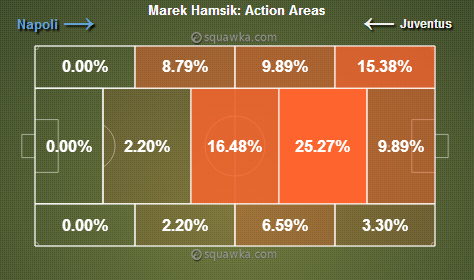There is no straw big enough to break this camel's back, and throughout the 2012-13 season they've shown incredible resilience and discipline to lock teams out.
The comparisons to "typical Italian defending" are all too easy to make, but this is notCatenaccio, this is Antonio Conte.
Let's break down the Old Lady's defensive structure and see why it works so well.
Shape
Conte, after brief flirtations with a 4-4-2, a 4-1-4-1 and a 4-3-3 (all of which included Giorgio Chiellini at left-back), settled on a 3-5-2 system featuring as much defensive excellence as offensive character.
 Juventus' 3-5-2 vs. Napoli in March 2013
Juventus' 3-5-2 vs. Napoli in March 2013
The first-choice trio is Andrea Barzagli (right), Leonardo Bonucci (centre) and GiorgioChiellini (left).
It's largely the same three that feature for Italy and, knowing each other's games inside out, move perfectly to cover gaps, openings and holes.
When in possession, they expand to cover the width of the pitch. This gives the ballplayer options to pass to, but it also (and critically) forces the wing-backs higher up the pitch to find room. They take a marker each with them, and all of a sudden, there's a midfield channel to pass through.
Bonucci has emerged as the ballplayer, and his skill set in this area improves by the game. Either he or Chiellini can elect to run into the channels and force matters further.
If nothing's on, the reliable Andrea Pirlo is always a good outlet.
Chiellini's previous exploits mean he's comfortable greeting a wide player on the counter, but Barzagli's lack of mobility often stops him from replicating this on the right.
No matter, as Conte has bought industrious wing-backs to compliment his line.
Stephan
Lichtsteiner is a man who has been reinvented in Turin—his career was stalling at
Lazio, and he looked like an average right-back—and his high-octane style of play is perfect for the right-winger role he assumes.
 Juventus' 3-5-2 vs. Chelsea in 2012
Juventus' 3-5-2 vs. Chelsea in 2012
Kwadwo Asamoah, a summer recruit from
Udinese, was thrust in at left-winger but took to the role like a duck to water, replacing the suspect Paolo De
Ceglie. In January,
Conte reinforced the position with the signing of Federico
Peluso, giving himself two very different options in that area.
Asamoah is a lung-busting athlete who attacks as well as he defends, while Peluso is a more careful, gentle player who provides stability and presence on the left rather than a genuine creative outlet.
When the wing-backs engage the opposing wide men in their own half, the back three shrinks into a deep line and the players stand just three or four yards apart. With Pirlodropping in too, the Bianconeri effectively crowd out the penalty area with three aerially proficient centre-backs and a holding midfielder to bottleneck the middle of the pitch.
Against Celtic (at Celtic Park)
Celtic played a 4-3-3 formation and committed both of Conte's wing-backs into marking the wingers. This allowed Emilio Izaguirre and Mikael Lustig to creep up and fire in accurate, deep crosses.
Even though Juve could do nothing to stop these early crosses, they comfortably dealt with every single aerial bombardment.
Izaguirre fired in 12 crosses,
Lustig nine, Charlie
Mulgrew eight. As accurate as some were, they were cleared with ease by a colossal defensive presence.
Barzagli made 13 clearances, Martin
Caceres 12,
Bonucci nine. Gary Hooper, who played as a central striker, failed to win a single aerial duel.
Juventus placed
Pirlo and Co. on the edge of their own box to block the middle and allowed the crosses, knowing they'd be impenetrable.
Against Napoli (at the Stadio San Paolo)
Conte came up against a 3-5-2/3-4-3 shape here, and that meant one-on-one battles for the wing-backs to contend with.
Peluso was the surprise pick on the left to face the returning, explosive ChristianMaggio, but he did a grand job for 70 minutes.
 via Squawka.com
via Squawka.com
Lichtsteiner locked up the right side against Carlos
Zuniga in similar fashion, and that left
Napoli without a presence in the wide areas. With the sidelines locked down (unlike in the Celtic match), the
Partenopei had no choice but to drive through the centre.
There, they met a brick wall in Pirlo and Co., and this graph illustrates the struggles Marek Hamsik had in creating. He hovered around the edge of the box but never found space to penetrate, often recycling the ball or wasting possession.
Conclusion
Juventus are beatable, but teams will be hard-pushed to do so.
With Chiellini back, things will only get better for the Old Lady. Barcelona struggled with Milan, but this is another level entirely as they combine the attack—which we've barely touched on—with the defence rather than sacrificing it.
fonte: http://bleacherreport.com
 Juventus' 3-5-2 vs. Napoli in March 2013
Juventus' 3-5-2 vs. Napoli in March 2013 Juventus' 3-5-2 vs. Chelsea in 2012
Juventus' 3-5-2 vs. Chelsea in 2012 via Squawka.com
via Squawka.com